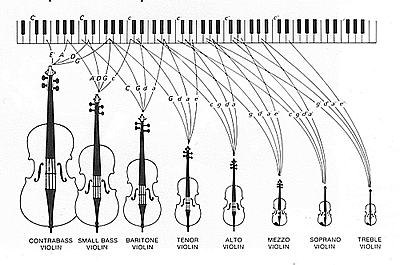
The Eight New Violins
The Violin Octet is a consort of violin-family instruments of graduated sizes, one at each half octave, from a seven-foot contrabass to a tiny treble violin tuned an octave above the standard violin. The Violin Octet represents the fruition of a concept that has been in the minds of creative musicians and instruments builders since the Sixteenth Century. Such a consort has never before been musically successful until the present collaboration between string players, composers, violin makers, musicologists, and acousticians. Hans Astraand, President of the Swedish Royal Academy of Music, has said, "These new instruments are the first time in history a consistent theory of acoustics has been successfully applied to a whole family of violin-type instruments.”
The Violin Octet instruments are capable of producing the acoustic qualities needed for music in the 21st century; increased string power, wider dynamics, extended frequency ranges, enhanced pizzicatos, and tonal combinations never before heard that span the range of written music. Over the last thirty years the musical qualities of these instruments have challenged composers to write and arrange over 300 pieces of music, not only for the whole ensemble, but for smaller groupings, soloists, and in very effective combinations with the human voice in all ranges.
The present effort was brought into focus in 1957 when Henry Brant, the composer then in residence at Bennington College, came to Carleen Hutchins looking for a violin maker “crazy enough to try a new idea.” He wanted a set of seven “violins” graduated in size, one at each half-octave through the range of written music, that would have the characteristic clarity, brilliance, evenness, and power of the violin on all four strings, not the tonal qualities of the viola and cello, beautiful though they are. Augmenting the violin, the new set would create a consort of eight acoustically matched violins. It only took a half-hour discussion with Brant for Hutchins to agree, but it took her ten years to complete the first Octet.
About halfway through the project, musicologist Steven Bonta brought Hutchins a book, Syntagma Musicum, written in 1619 by Michael Praetorius, in which Praetorius described seven geigen (violins) in much the same tunings as Hutchins and her colleagues were developing. Bonta was excited to discover that the baritone violin (large cello) under development had exactly the same dimension and string length as an instrument Praetorius had pictured in his book; so also the contrabass violin.
A description of the work in developing each new instrument was published in Physics Today (Vol. 20, no. 2, Feb. 1967), “Founding a Family of Fiddles” (Hutchins pp. 23-37). This can also be found on the website of the Catgut Acoustical Society. This organization, which started with 20 members in 1963 and grew to over 800 in 36 countries, nurtured the Violin Octet from 1963 until 1999 when the New Violin Family Association split off as a separate organization dedicated to the future development and musical acceptance of these new instruments.
The first public concert of The Violin Octet was at the YM-YWHA in New York City in 1962 to an astonished and excited audience including the famous conductor Leopold Stokowski who said, “That is the sound I have always wanted from the violas in my orchestra. It fills the entire hall.” In the 30 years since then these instruments have been on tour around the world generating much interest and enthusiasm wherever they are heard. With seven sets of the new instruments now in prestigious institutions worldwide and four more under construction, one in Genoa, Italy, one in Belgium, one in Australia, and one in the USA, the Violin Octet is now being recognized internationally. Hutchins has presented over two hundred lecture-demonstrations and concerts to audiences in London, Edinburgh, Stockholm, St. Petersburg, Berlin, Tokyo, Beijing, Hong Kong, the Metropolitan Museum of Art in NYC, the National Music Museum in Vermilion, South Dakota, as well as numerous universities and other places in the USA and Canada.
An Octet spent three years in the Royal College of Music, London, where their new sounds were explored and new music composed for them. Another Octet was loaned for three years to the Conservatory of Music, St. Petersburg, Russia, where eight distinguished professionals and professors performed many concerts with standing ovations and enthusiastic reviews, with several fine recordings and new compositions resulting. There is now an Octet in New York City where jazz and avant-guard musicians are using them with great enthusiasm. Currently visitors to the Metropolitan Museum of Art in New York City can view the museum’s own Violin Octet displayed in its musical instrument collection. The exhibit was set up in conjunction with an Octet concert in the Grace Rainey Rogers auditorium of the museum in May 2002. This landmark event was played by the Hutchins Consort from California, the first professional octet in the U.S.A. The consort, now in its fourth year, concertizes extensively, particularly throughout the western states.
Hutchins could not possibly have created these instruments without knowledge of two important air and wood modes of the violin as distinguished from those of the viola, cello, and bass, as well as her experience in moving their frequencies around in various-size instruments. Nor could she have done it without free plate tuning, (see Hutchins, Scientific American, October 1981, pp 126-135), or the expert advice and help of over 100 associates in the Catgut Acoustical Society, two Guggenheim Fellowships, and several grants from the Martha Baird Rockefeller Fund For Music. For this work Hutchins has received four honorary doctorates and the Acoustical Society of America’s highest award, Honorary Fellow, given only 14 times, the first to Thomas Alva Edison.
